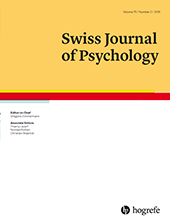The Impact of Regulatory Focus on Challenge and Threat
Abstract
Abstract. Research has shown that feelings of threat elicit a prevention focus and feelings of challenge elicit a promotion focus. The present research tested the reverse causal relationship. We predicted that, when people are faced with a demanding task, they experience more challenge and less threat if they are in a promotion focus as compared to a prevention focus because having a promotion focus results in the perception of having more resources than a prevention focus does. In two studies assessing or manipulating regulatory focus, respectively, we found the expected effect on challenge and threat as well as the mediation of this effect via perceived resources. The relationships between regulatory focus and challenge and threat are discussed.
References
(2001). I-S-T 2000 R. Intelligence Structure Test 2000 R (Expanded and revised ed., Vol. 2). Göttingen: Hogrefe.
(2011). When prevention promotes creativity: The role of mood, regulatory focus, and regulatory closure. Journal of Personality and Social Psychology, 100, 794–809. doi 10.1037/a0022981
(2004). Predicting athletic performance from cardiovascular indexes of challenge and threat. Journal of Experimental Social Psychology, 40, 683–688. doi 10.1016/j.jesp.2003.10.007
(1996).
The biopsychosocial model of arousal regulation . In M. P. ZannaEd., Advances in experimental social psychology (Vol. 28, pp. 1–51). San Diego, CA: Academic Press.(2001). The effects of promotion and prevention cues on creativity. Journal of Personality and Social Psychology, 81, 1001–1013. doi 10.1037/0022-3514.81.6.1001
(2009). Stereotype threat reinterpreted as a regulatory mismatch. Journal of Personality and Social Psychology, 96, 288–304. doi 10.1037/a0013463
(1997). Beyond pleasure and pain. American Psychologist, 52, 1280–1300. doi 10.1037/0003-066X.52.12.1280
(2007). When negative stereotypic expectancies turn into challenge or threat: The moderating role of regulatory focus. Swiss Journal of Psychology, 66, 163–168. doi 10.1024/1421-0185.66.3.163
(2012). Differential gender and ethnic differences in math performance: A self-regulatory perspective. Zeitschrift für Psychologie, 220, 164–171. doi 10.1027/2151-2604/a000109
(2008). Expectancy effects on cognitive test performance: Regulatory focus as a catalyst. European Journal of Social Psychology, 38, 187–212. doi 10.1002/ejsp.452
(2000). To do the right thing or to just do it: Locomotion and assessment as distinct self-regulatory imperatives. Journal of Personality and Social Psychology, 79, 793–815. doi 10.1037/0022-3514.79.5.793
(1984). Stress, appraisal, and coping. New York: Springer-Verlag.
(2001). Promotion and prevention focus on alternative hypotheses: Implications for attributional functions. Journal of Personality and Social Psychology, 80, 5–18. doi 10.1037/0022-3514.80.1.5
(2007). Unfair treatment and self-regulatory focus. Journal of Experimental Social Psychology, 43, 505–512. doi 10.1016/ j.jesp.2006.05.014
(1990). The stress appraisal measure (SAM): A multidimensional approach to cognitive appraisal. Stress Medicine, 6, 227–236. doi 10.1002/smi.2460060308
(2004). SPSS and SAS procedures for estimating indirect effects in simple mediation models. Behavior Research Methods, Instruments, and Computers, 36, 717–731. doi 10.3758/BF03206553
(2012). The attraction of social power: The influence of construing power as opportunity versus responsibility. Journal of Experimental Social Psychology, 48, 550–555. doi 10.1016/j.jesp.2011.11.008
(2015). Threat – prevention, challenge – promotion: The impact of threat, challenge and regulatory focus on attention to negative stimuli. Cognition and Emotion, 29, 188–195. doi 10.1080/02699931.2014.898612
(2015). Attracted to power: Challenge/threat and promotion/prevention focus differentially predict the attractiveness of group power. Frontiers in Psychology, 6, 1–9. doi 10.3389/fpsyg.2015.003
(2004). Stereotype threat and performance: How self-stereotypes influence processing by inducing regulatory foci. Journal of Personality and Social Psychology, 87, 38–56. doi 10.1037/0022-3514.87.1.38
(1997). A threat in the air: How stereotypes shape the intellectual identities and performance of women and African-Americans. American Psychologist, 52, 613–629. doi 10.1037/0003-066X.52.6.613
(1993). Subjective, physiological, and behavioral effects of threat and challenge appraisal. Journal of Personality and Social Psychology, 65, 248–260. doi 10.1037/0022-3514.65.2.248
(1997). Cognitive and physiological antecedents of threat and challenge appraisal. Journal of Personality and Social Psychology, 73, 63–72. doi 10.1037/0022-3514.73.1.63



